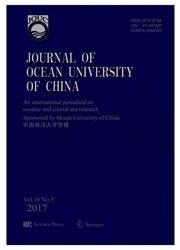

 中文摘要:
中文摘要:
In this paper, the distribution patterns and abundance of pelagic tunicates in the North Yellow Sea of China during the period 2006-2007 were analyzed. Zooplankton samples were obtained with vertical towing from bottom to surface using a WP2 plankton net(200 μm mesh size; mouth area: 0.25 m2). Five species belonging to two classes were identified: Oikopleura dioica, O. longicauda and Fritillaria borealis belonging to class Appendicularia; Salpa fusiformis and Doliolum denticulatum of class Thaliacea. O. dioica and O. longicauda were the dominant species, occurring in the samples of all four seasons, with different distribution patterns. Their maximum abundance were 1664.7 ind. m-3(spring) and 1031.7 ind. m-3(spring) respectively. Following Oikopleura spp. were D. denticulatum, which was found only in autumn with an average abundance of 149.6 ind. m-3, and S. fusiformis, which was detected all the year long except for autumn with low abundance(max. abundance 289.4 ind. m-3 in summer). Only a very small amount of F. borealis was detected in summer samples, with an average abundance of 2.7 ind. m-3. The relationship between tunicates abundances and the environmental factors was analyzed using the stepwise regression model for each species. The variation of appendicularian abundance showed a significant correlation with the surface water temperature and with the concentration of Chl-a. No relationship was found between tunicates abundance and salinity, likely due to the slight changes in surface salinity of the studied area during the four seasons. Salps abundance and that of doliolids were significantly correlated to bottom water temperature, indicating that these two species(S. fusiformis and D. denticulatum) migrate vertically in the water column. In particular D. denticulatum, known to be a warm water species, showed not only an important correlation with water temperature, but also a spatial distribution connected to the warm currents in the North Yellow Sea. The occurrence of D. denticulatum represents an inte
 英文摘要:
英文摘要:
In this paper, the distribution patterns and abundance of pelagic tunicates in the North Yellow Sea of China during the period 2006-2007 were analyzed. Zooplankton samples were obtained with vertical towing from bottom to surface using a WP2 plankton net(200 μm mesh size; mouth area: 0.25 m2). Five species belonging to two classes were identified: Oikopleura dioica, O. longicauda and Fritillaria borealis belonging to class Appendicularia; Salpa fusiformis and Doliolum denticulatum of class Thaliacea. O. dioica and O. longicauda were the dominant species, occurring in the samples of all four seasons, with different distribution patterns. Their maximum abundance were 1664.7 ind. m-3(spring) and 1031.7 ind. m-3(spring) respectively. Following Oikopleura spp. were D. denticulatum, which was found only in autumn with an average abundance of 149.6 ind. m-3, and S. fusiformis, which was detected all the year long except for autumn with low abundance(max. abundance 289.4 ind. m-3 in summer). Only a very small amount of F. borealis was detected in summer samples, with an average abundance of 2.7 ind. m-3. The relationship between tunicates abundances and the environmental factors was analyzed using the stepwise regression model for each species. The variation of appendicularian abundance showed a significant correlation with the surface water temperature and with the concentration of Chl-a. No relationship was found between tunicates abundance and salinity, likely due to the slight changes in surface salinity of the studied area during the four seasons. Salps abundance and that of doliolids were significantly correlated to bottom water temperature, indicating that these two species(S. fusiformis and D. denticulatum) migrate vertically in the water column. In particular D. denticulatum, known to be a warm water species, showed not only an important correlation with water temperature, but also a spatial distribution connected to the warm currents in the North Yellow Sea. The occurrence of D. denticu
 同期刊论文项目
同期刊论文项目
 同项目期刊论文
同项目期刊论文
 期刊信息
期刊信息
